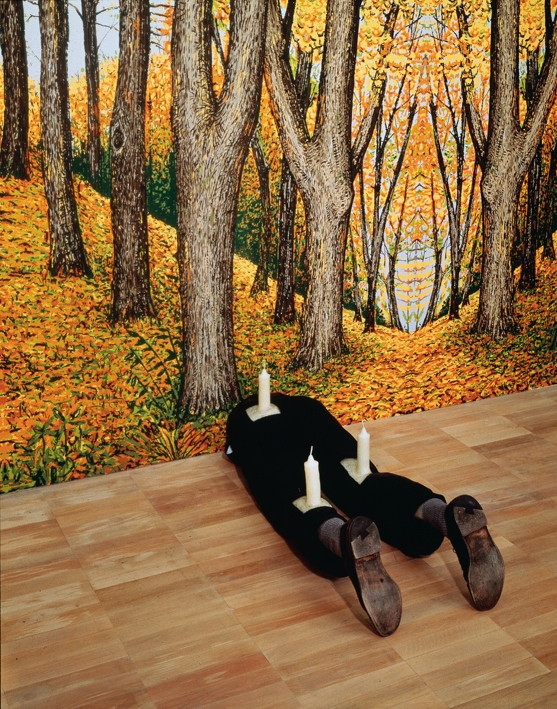Few, if any, artists have delved so trenchantly into the existential hypocrisy of latter-day America – the creed of equality masking ingrained racism, sexism and homophobia; sanctimonious conservative mores belied by an adolescentlike indulgence in drugs and too-often-predatory sex; the consumption of schlock trumpeted as the world’s highest middle-class standard of living – as Mike Kelley and Robert Gober, both sons of 1950s Catholic families of modest means. Kelley, in his reenactments of high school pageants, photos of naked adults soiling stuffed animals and of his own acne-inflamed teenage face, and drawings of garbage dumps, strips away such constructed veneers of innocence and convention to reveal the ghastly sadism, tackiness and personal insecurity that define formation in, at least, babyboomer American culture. In contrast, Gober’s puzzling, reticent objects and installations – both he and Kelley are masters of the latter form – at once present the veneer and pierce it.
In his replica boxes of rat bait and the bags of cat litter, for example, he works with objects that control the filth Kelley indulges, and in his pewter drains embedded in gallery walls, ones that facilitate transitions between home and sewer, he offers up states of suspended identity (such as the sinks that lack taps and piping, which seem lifted from some enigmatic, unfolding ritual). He posits the human condition as an equivalence between the creations of the mind and of the gut, most potently in Untitled (1990), a waxwork of naked buttocks printed with a musical score and punctuated by a light brown hole. He gives us plaster, paint, wood, cast crystal, etc, all the materials precisely listed on the wall labels, which have been made to look like something else entirely – hairy candles, trompe l’oeil plywood, submerged bodies – through his meticulous craft.
Gober does not aim to create metaphors. As signalled by the show’s title, he attempts to realise the physical and spiritual embodiment of the heart; or, given his frequent use of Catholic imagery, an artistic version of the dictum ‘God is Love’. Just as the host transcends the immediate, physical world, his pieces exist simultaneously in the here of the viewer and in a dimension defined by the care and content he vests in his work: the fragility of childhood, the status of same-sex attraction, the nature of intimacy, all themes that suggest love as he envisions it and thus how society perverts it.
Heavily reliant on personal references, as suggested by the exceptionally detailed chronology that comprises the better part of the exhibition catalogue and that edges into hagiographic minutiae, his art nevertheless often – and in this dense exhibition, quickly – becomes recondite and overly baroque, as in, say, Untitled (2012), an inverted sink, the backsplash of which mimics driftwood woven with human limbs. In other cases it can be overly obvious, as with Untitled (1994–5), a fireplace filled with children’s legs. But Gober’s chronology also suggests the marvellous specificity of an individual life, and particularly in his sinks and cribs, he evokes the body and its absence in ways that remain evocative, mysterious and almost transcendent.
This article was first published in the March 2015 issue.
